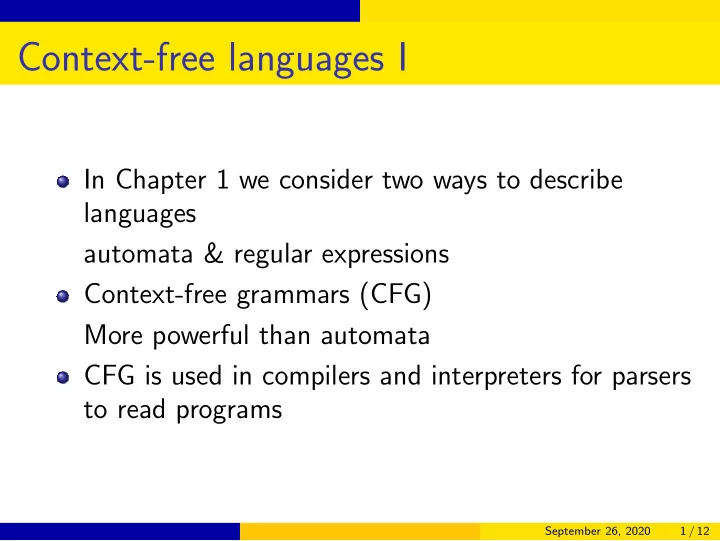

Context-free languages I In Chapter 1 we consider two ways to describe languages automata & regular expressions Context-free grammars (CFG) More powerful than automata CFG is used in compilers and interpreters for parsers to read programs September 26, 2020 1 / 12
Context-free grammars I A grammar G 1 : A → 0 A 1 A → B B → # Each one is called a substitution rule Variables: A , B (capital letters) Terminals: 0, 1, # (lowercase letters, number, special symbols) Start variable: A September 26, 2020 2 / 12
Context-free grammars II A grammar: a collection of substitution rules Derivation: G 1 generates 000#111 A ⇒ 0 A 1 ⇒ 00 A 11 ⇒ 000 A 111 ⇒ 000 B 111 ⇒ 000#111 Parse tree Fig 2.1 September 26, 2020 3 / 12
Context-free grammars III A A A A B 0 0 0 # 1 1 1 September 26, 2020 4 / 12
Context-free grammars IV L ( G ): language of grammar For the CFG example we just discussed, L ( G 1 ) = { 0 n #1 n | n ≥ 0 } CFG is more powerful than regular expressions because we showed earlier that this language is not regular Representation of rules: A → 0 A 1 and A → B is often simplified to September 26, 2020 5 / 12
Context-free grammars V A → 0 A 1 | B Example � S � ⇒ � Noun-Phrase �� Verb-Phrase � ⇒ � Complex-Noun �� Verb-Phrase � ⇒ � Article �� Noun �� Verb-Phrase � ⇒ a � Noun �� Verb-Phrase � ⇒ a boy � Verb-Phrase � ⇒ a boy � Complex-Verb � ⇒ a boy � Verb � ⇒ a boy sees September 26, 2020 6 / 12
Context-free grammars VI Why called “context-free” ? Rules independent of context September 26, 2020 7 / 12
Formal definition of a context-free grammar I ( V , Σ , R , S ) V : variables, finite set Σ: terminals, finite set R : rules variable → strings of variables and terminals (including ǫ ) S ∈ V , start variable September 26, 2020 8 / 12
Formal definition of a context-free grammar II For the example G 1 : A → 0 A 1 A → B B → # V = { A , B } , Σ = { 0 , 1 , # } , S = A , R : the above three rules September 26, 2020 9 / 12
Derivation of strings I If u , v , w are strings and a rule A → w is applied, then we say uAv yields uwv and this is denoted as uAv ⇒ uwv if u = v or u ⇒ u 1 ⇒ · · · ⇒ u k ⇒ v then we say ∗ u ⇒ v September 26, 2020 10 / 12
Derivation of strings II Language of a CFG { w ∈ Σ ∗ | S ∗ ⇒ w } September 26, 2020 11 / 12
Example 2.3 I G 3 = ( { S } , { a , b } , R , S ) R: S → aSb | SS | ǫ What is the language? If we treat a , b respectively as ( and ), then we have all valid nested parentheses September 26, 2020 12 / 12
Recommend
More recommend